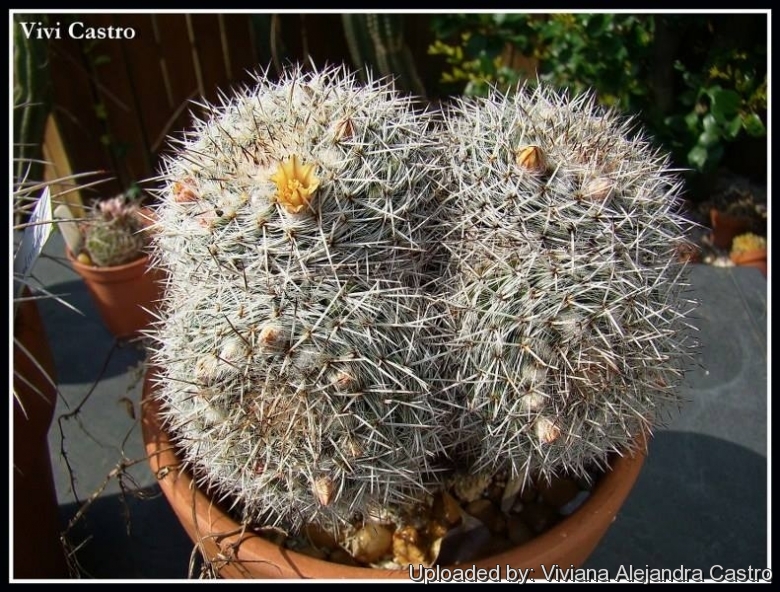
Mammillaria parkinsonii Photo by: Viviana Alejandra Castro
Origin and Habitat: This species is endemic to Central Mexico, where it occurs in the state of Querétaro de Arteagaand into Hidalgo along the border of the Querétaro river. Extent of occurrence ca 2,500 km2
Altitude: 1.200-2.400 metres over sea level
Habitat: Mammillaria parkinsoniiSN|20725]]SN|20725]] grows on lime rich soils and calcareous substrate in semi-desert areas characterized by warm-temperate and dry climate. It is severely fragmentation in small sub-populations and occurs in xerophyllous scrub and submontane matorral. Illegal collection and land use change are threats across the range of the species. This cactus is used as an ornamental, and is normally found elsewhere as propagated plants.
Synonyms:
See all synonyms of Mammillaria parkinsonii
Common Names include:
ENGLISH: Owl's-eye Pincushion, Owl's-eye, Owl-eye cactus, Owl-eye pincushion
FRENCH (Français): Yeux-de-hibou
Description: Mammillaria parkinsoniiSN|20725]]SN|20725]] is a woolly, mound forming species, that, as it ages, tufts by dichotomic division forming compact bunches up to 60 cm in diameter (or more). This species is especially variable in spine length.
Stem: Glaucous green, globose to shortly cylindrical up to about 15 cm tall, 8 to 15 cm wide, slightly depressed at apex, covered at the centre by a white wool;
Tubercles: Spirally arranged, 8-10 mm long, 4-6 mm broad, pyramidal, with latex, axil woolly and silky.
Areoles: At first with abundant white felt, becoming naked as they ages.
Central spines: 2 (sometime 3-4 or rarely 5) usually bent downwards, rigid and whitish with dark brown tips, often purple red coloured on the new growth, the upper one, 4-8 mm long, the lower one up to 35 mm long often subulate.
Radial spines: 20-30 (or more) white, thin and slightly bent, 4-6 mm long.
Flowers: Diurnal, funnel-shaped, pale yellow with a central brownish or pinkish midvein, 12-15 mm long and in diameter, inner perianth segments apiculate; stigma lobes elongated. The flowers born in a circle close to the apex and originate from the areolae at the base of the tubercles. Flowers bud are surrounded by a mass of white wool.
Fruits: Club-shaped, about 10 mm long, orange red to scarlet.
Seeds: Pyriform, about 1,5 mm long, brown, edible.
Subspecies, varieties, forms and cultivars of plants belonging to the Mammillaria parkinsonii group
Notes: This is one of the Mammillaria commonly called "Owl Eye Cactus", known for dichotomous branching (forking or dividing into two parts). Although dichotomous branching is not a common occurrence in cacti in general, it happens for some reason in this particular species. What is interesting about this cactus is that it began as a single head, one head became two, and so on. Other Owl Eye Cactus among others comprise Mammillaria karwnskiana, Mammillaria formosaSN|15832]]SN|15832]], Mammillaria microthele and Mammillaria perbella.
Bibliography: Major references and further lectures.
1) Sánchez , E., Guadalupe Martínez, J. & Bárcenas Luna, R. 2013. Mammillaria parkinsonii. The IUCN Red List of Threatened Species. Version 2014.2. <www.iucnredlist.org>. Downloaded on 02 November 2014.
2) Wikipedia contributors. "Mammillaria parkinsonii." Wikipedia, The Free Encyclopedia. Wikipedia, The Free Encyclopedia, 15 May. 2014. Web. 2 Nov. 2014.
3) Robert T. Craig “The Mammillaria handbook: with descriptions, illustrations, and key to the species of the genus Mammillaria of the Cactaceae” E P Publishing, 1945
4) John Pilbeam “Mammillaria The Cactus File Handbook” Cirio Pub. Services, 01/Dec/1999Edward Anderson “The Cactus family” Timber Press, Incorporated, 2001
5) James Cullen, Sabina G. Knees, H. Suzanne Cubey "The European Garden Flora Flowering Plants: A Manual for the Identification of Plants Cultivated in Europe, Both Out-of-Doors and Under Glass" Cambridge University Press, 11/Aug/2011
6) David R Hunt; Nigel P Taylor; Graham Charles; International Cactaceae Systematics Group. "The New Cactus Lexicon" dh books, 2006
 Mammillaria parkinsonii Photo by: Valentino Vallicelli
Mammillaria parkinsonii Photo by: Valentino Vallicelli Mammillaria parkinsonii Photo by: Valentino Vallicelli
Mammillaria parkinsonii Photo by: Valentino Vallicelli Mammillaria parkinsonii Photo by: Valentino Vallicelli
Mammillaria parkinsonii Photo by: Valentino VallicelliSend a photo of this plant.The gallery now contains thousands of pictures, however it is possible to do even more. We are, of course, seeking photos of species not yet shown in the gallery but not only that, we are also looking for better pictures than those already present.
Read More... Cultivation and Propagation: It is a summer grower plant cultivated and appreciated by the collectors as it offers no cultivation difficulties.
Growing substrate: Needs a loose free draining mix which can be formed by about the 30-50% of common, manured, garden earth and for the rest, in equal quantity, by pumice or lava grit and sand (or agriperlite).
Watering: Water regularly in summer (but do not overwater ), but allowing the mould to dry up completely before giving water again, keep rather dry in winter, this resting period, cool and dry, is indispensable for a good blossoming.
Fertilization: Feed with a high potassium fertilizer in summer.
Hardiness: It is quite frost resistant if kept dry (hardy to -5° C) but for a safe cultivation avoid freezing temperatures.
Sun Exposure: Needs full sun or, however, at the maximum possible luminosity, but can tolerate light shade.
Maintenance: In order to keep the clumps compact, high light levels and steady growth are needed; otherwise there is the danger of having a number of elongated heads that are somewhat separated from one another. Frequent transplantations of the young plants protect the lower part of the stem from the lignification, to which the plant has a tendency.
Reproduction: It is propagated by seed. Sometimes old plants divide at their apex, ramifying dichotomously - to form two or more distinct joints - but the removal of one of these joints may prove fatal to the plant.













